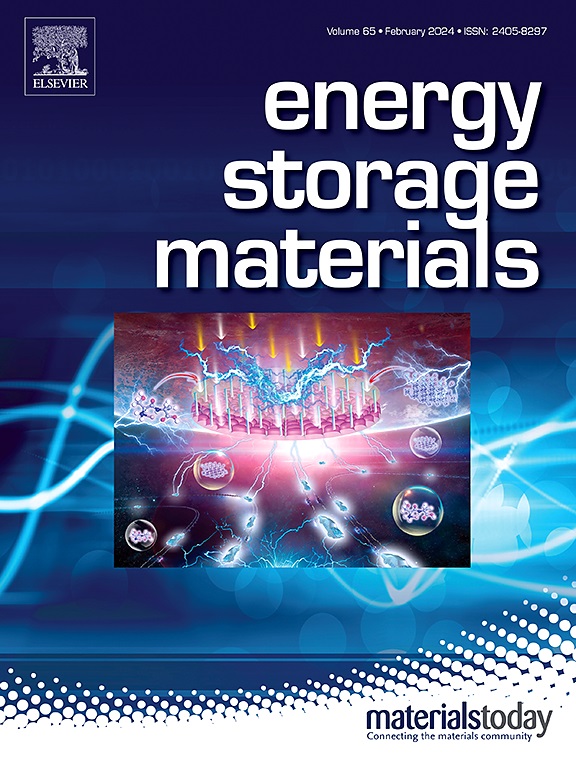Boosting high-loading zinc-ion battery performance: Zn-Doped δ-MnO2 cathodes to promote Zn2+ storage
IF 20.2
1区 材料科学
Q1 CHEMISTRY, PHYSICAL
引用次数: 0
Abstract
Rechargeable aqueous zinc-ion batteries (AZIBs) have emerged as a leading contender for stationary energy storage systems due to their low cost, safety, and environmental sustainability. However, their widespread practical application is hindered by the limited stability and capacity of current AZIB cathodes, such as manganese oxide (MnO2), which affects their long-term cost-effectiveness. To overcome this limitation, we introduce zinc (Zn) doping in δ-MnO2, which modulates the electronic states of Mn atoms, suppresses Jahn–Teller distortion, and enhances structural stability. Additionally, the use of a binder-free, self-supported porous electrode without current collectors facilitates three-dimensional ion diffusion, further improving electrochemical performance. As a result, the assembled AZIBs demonstrate outstanding rate capability, delivering 440 mAh∙g-1 at 0.2 A∙g-1 and retaining 118 mAh∙g-1 at 24 A∙g-1 for Zn-doped δ-MnO2, outperforming the bare δ-MnO2 with 356 mAh∙g-1 at 0.2 A∙g-1 and 80 mAh∙g-1 at 24 A∙g-1. Additionally, the Zn-doped δ-MnO2 exhibits excellent cycling performance with ∼100 % capacity retention after 6000 cycles at 150 mAh∙g-1 at 10 A∙g-1. Furthermore, Zn-doped MnO2 electrodes integrated with carbon nanotubes achieve a high capacity of ∼210 mAh∙g-1, even at an ultrahigh mass loading (∼20 mg∙cm-2) at 0.6 mA∙g-1. While energy storage in MnO2 involves the reaction and insertion of H+, Mn2+, and Zn2+ cations, density functional theory calculations reveal that Zn intercalation is the dominant storage mechanism in these cells. Overall, this study highlights the potential of Zn-doped MnO2 cathodes as a promising strategy for advancing the stability, capacity, and rate performance of next-generation AZIBs.
提高高负载锌离子电池性能:掺锌δ-MnO2阴极促进Zn2+存储
可充电水性锌离子电池(azib)因其低成本、安全性和环境可持续性而成为固定式储能系统的主要竞争者。然而,目前AZIB阴极(如氧化锰(MnO2))的稳定性和容量有限,影响了它们的长期成本效益,阻碍了它们的广泛实际应用。为了克服这一限制,我们在δ-MnO2中引入锌(Zn)掺杂,从而调节Mn原子的电子态,抑制jhn - teller畸变,提高结构稳定性。此外,使用无粘结剂、无集流器的自支撑多孔电极有助于三维离子扩散,进一步提高电化学性能。结果,组合的AZIBs表现出出色的倍率能力,在0.2 a∙g-1时提供440 mAh∙g-1,在24 a∙g-1时为掺杂锌的δ-MnO2保持118 mAh∙g-1,优于裸δ-MnO2在0.2 a∙g-1时的356 mAh∙g-1和24 a∙g-1时的80 mAh∙g-1。此外,掺锌的δ-MnO2表现出优异的循环性能,在150 mAh∙g-1和10 A∙g-1下循环6000次后,容量保持率为~ 100%。此外,与碳纳米管集成的锌掺杂MnO2电极即使在0.6 mA∙g-1的超高质量负载(~ 20 mg∙cm-2)下也能获得~ 210 mAh∙g-1的高容量。虽然MnO2中的能量存储涉及H+、Mn2+和Zn2+阳离子的反应和插入,但密度功能理论计算表明,Zn嵌入是这些细胞中主要的存储机制。总的来说,本研究强调了锌掺杂MnO2阴极作为提高下一代azib的稳定性、容量和速率性能的有前途的策略的潜力。
本文章由计算机程序翻译,如有差异,请以英文原文为准。
求助全文
约1分钟内获得全文
求助全文
来源期刊

Energy Storage Materials
Materials Science-General Materials Science
CiteScore
33.00
自引率
5.90%
发文量
652
审稿时长
27 days
期刊介绍:
Energy Storage Materials is a global interdisciplinary journal dedicated to sharing scientific and technological advancements in materials and devices for advanced energy storage and related energy conversion, such as in metal-O2 batteries. The journal features comprehensive research articles, including full papers and short communications, as well as authoritative feature articles and reviews by leading experts in the field.
Energy Storage Materials covers a wide range of topics, including the synthesis, fabrication, structure, properties, performance, and technological applications of energy storage materials. Additionally, the journal explores strategies, policies, and developments in the field of energy storage materials and devices for sustainable energy.
Published papers are selected based on their scientific and technological significance, their ability to provide valuable new knowledge, and their relevance to the international research community.
 求助内容:
求助内容: 应助结果提醒方式:
应助结果提醒方式:


